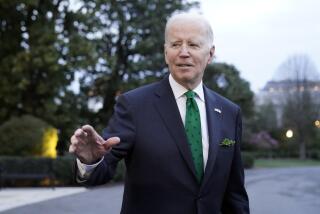Big Firms Face Added Burden in Health Plan
- Share via
WASHINGTON — Despite White House assurances that no business would have to pay more than 7.9% of its payroll to finance employee health insurance, President Clinton’s health care advisers may ask him to set that cap as high as 8.5% for large employers, White House sources said Monday.
A higher limit on employer contributions would raise tens of billions of additional dollars to help subsidize premium payments by small businesses. Under the Clinton plan, employers would be required to pay at least 80% of a worker’s insurance premiums, with employees responsible for the remainder.
The debate among top-level Administration officials on a higher-than-acknowledged employer contribution limit reflects their growing unease over widespread criticism that the President’s sweeping agenda lacks adequate financing.
To pay for universal coverage for the 37 million uninsured Americans, Clinton’s plan would impose only one tax increase: a cigarette tax of between 75 cents and $1 per pack. At the same time, the plan projects savings from economies in the health care system of $700 billion over seven years--a claim that has aroused considerable doubt, even though the President and his top aides have strongly defended the figures.
In various White House documents, including position papers disseminated to members of Congress last week, the Administration stated unequivocally that 7.9% of payroll would be the most any business would have to pay.
But informed sources said Monday that some planners in the Administration are talking privately about a significantly higher cap on employer premium contributions.
“We’ve settled in at 7.9% for now. But it’s conceivable that it could move a bit,” Ira Magaziner, the senior White House adviser for policy development, confirmed Monday. “We’re still refining the numbers.”
As the President’s plan moves from a proposal to detailed legislation that will be considered by Congress next month, changes are certain to be made. Raising the cap on employer contributions is one major adjustment that could adversely affect big business, whose support is seen as crucial for passage of health reform.
Clinton advisers, looking for more ways to generate private-sector funds, also are contemplating a timetable under which employers with 50 or more workers would have no payroll cap on premium contributions until four years after comprehensive health reform is enacted. Even then, they would be permitted to reduce their premium contributions only gradually until they reached the limit set by the cap, Administration sources said. The change would raise tens of billions more dollars.
Another provision under contention is the Administration’s proposal that the federal government pay 80% of the health benefits corporations now pay for workers who retired early.
“There’s lots of talk about scaling that back,” said one senior Administration health analyst.
As proposed, the provision--which could cost an estimated $4 billion by the year 2000--would be a major boon to automobile and steel manufacturers, as well as to other industries that are paying for the health benefits of early retirees until they reach age 65 and qualify for Medicare.
Also on Monday, Judy Feder, another top Administration health planner, told a business group here that the President’s agenda, if enacted, would mean that as many as 1 in 3 Americans--mostly the underinsured and healthy young people--would probably pay more under comprehensive health care reform.
In an interview, Magaziner explained the possible increase on the employer contribution cap by saying that such numbers are subject to change as a result of the Administration’s continuing consultations with interest groups and members of Congress. Given the intricately entwined elements of the health care reform agenda, he said, the alteration of any one element can require changes in the financial projections.
“We are getting a lot of comments from (Capitol) Hill and elsewhere, and we are serious about this consultation,” Magaziner said.
As recently as Sept. 10, First Lady Hillary Rodham Clinton, in a speech at George Washington University to a group of state legislators, said that businesses would pay “no more than 8%” of payroll in contributions to employee premiums.
But that was only “a rough approximation,” Magaziner said Monday.
Under the Clinton health reform plan, consumers would be grouped into large “alliances” that would be empowered to shop among groups of doctors and hospitals for the best prices and quality. The main financing mechanism would be the so-called employer-employee mandate.
Of the estimated 37 million uninsured Americans, about 85% already are employed. Thus the government mandate would go a long way toward achieving universal coverage.
Because the mandate would be burdensome to low-wage earners and small businesses, firms with fewer than 50 workers whose wages average less than $24,000 a year would be eligible for federally subsidized discounts calculated on a sliding scale.
Under the mandate, individuals would not have to pay more than 1.9% or 2% of their salaries.
To help create a “national subsidy pool,” the White House expects to raise $105 billion over seven years through the cigarette tax increase and a probable 1% “assessment” on companies with more than 5,000 workers that opt to create their own “corporate alliances.”
When Mrs. Clinton, who led the White House Task Force on Health Care Reform, spoke here Sept. 10, she argued strongly that large employers stand to benefit greatly from the employer-employee mandate--with a cap on total premium contributions.
“For most large businesses, who have borne the cost of health insurance in many regions of the country, their cost will drop dramatically because we will cap the amount of money that any business has to pay for health care and we will cap significantly below what the average employer pays now,” Mrs. Clinton said, adding that many corporations are paying between 10% and 14% of their payroll in health insurance premiums.
Numerous studies have estimated that the nation’s employers now pay an average of between 9.9% and 13.5% of their payroll in health premiums. But Administration officials have maintained that a cap of about 7.9% would be sufficient because comprehensive health reform would bring lowered medical costs in general.
* HEALTH HEARINGS: Congress begins work on Clinton’s reform proposals. A14
More to Read
Get the L.A. Times Politics newsletter
Deeply reported insights into legislation, politics and policy from Sacramento, Washington and beyond. In your inbox three times per week.
You may occasionally receive promotional content from the Los Angeles Times.










